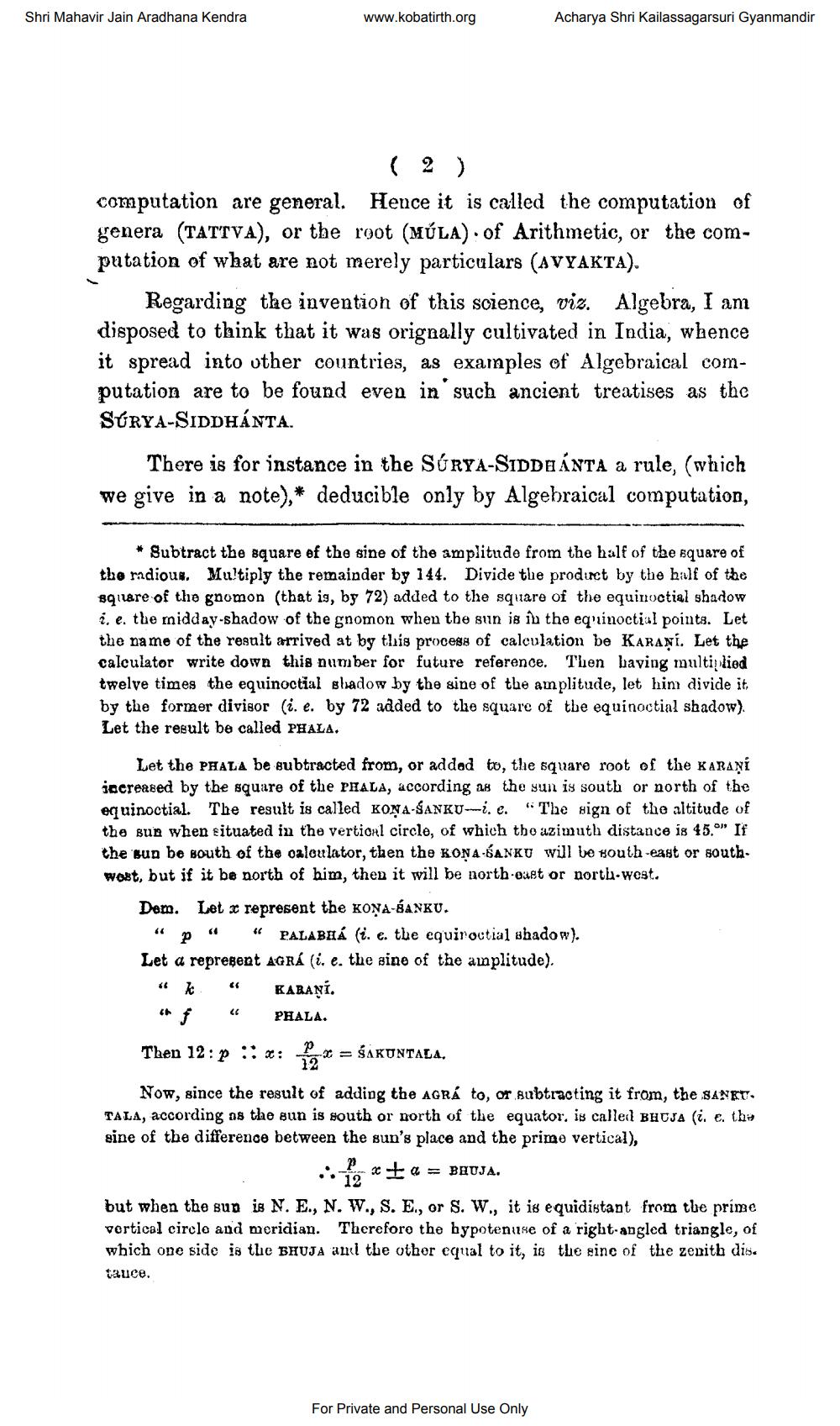Book Title: Bijganit Purvarddh Author(s): Bapudev Shastri Publisher: Medical Hall Press View full book textPage 5
________________ Shri Mahavir Jain Aradhana Kendra www.kobatirth.org ( 2 ) computation are general. Hence it is called the computation of genera (TATTVA), or the root (MÚLA) of Arithmetic, or the computation of what are not merely particulars (AVYAKTA). Regarding the invention of this science, viz. Algebra, I am disposed to think that it was orignally cultivated in India, whence it spread into other countries, as examples of Algebraical computation are to be found even in such ancient treatises as the SURYA-SIDDHANTA. There is for instance in the SURYA-SIDDHANTA a rule, (which we give in a note),* deducible only by Algebraical computation, Acharya Shri Kailassagarsuri Gyanmandir * Subtract the square of the sine of the amplitude from the half of the square of the radious. Multiply the remainder by 144. Divide the product by the half of the square of the gnomon (that is, by 72) added to the square of the equinoctial shadow i. e. the midday-shadow of the gnomon when the sun is in the equinoctial points. Let the name of the result arrived at by this process of calculation be KARANI. Let the calculator write down this number for future reference. Then having multiplied twelve times the equinoctial shadow by the sine of the amplitude, let him divide it. by the former divisor (i. e. by 72 added to the square of the equinoctial shadow). Let the result be called PHALA. Let the PHALA be subtracted from, or added to, the square root of the KARANI increased by the square of the PHALA, according as the sun is south or north of the equinoctial. The result is called KONA-SANKU-i. e. "The sign of the altitude of the sun when situated in the vertical circle, of which the azimuth distance is 45." If the sun be south of the calculator, then the KONA SANKU will be south-east or southwest, but if it be north of him, then it will be north-east or north-west. ck 66 Dem. Let x represent the KONA-BANKU. 66 64 P PALABHA (i. e. the equinoctial shadow). Let a represent AGRA (i. e. the sine of the amplitude). KARANI. "k 66 " f Then 12 px: PHALA. 12x Now, since the result of adding the AGRA to, or subtracting it from, the SANEU TALA, according as the sun is south or north of the equator. is called BHUJA (i. e. the sine of the difference between the sun's place and the prime vertical), xα = BHUJA. SAKUNTALA, :: 12 but when the sun is N. E., N. W., S. E., or S. W., it is equidistant from the prime vertical circle and meridian. Therefore the hypotenuse of a right-angled triangle, of which one side is the BHUJA and the other equal to it, is the sine of the zenith dis. tauce. For Private and Personal Use OnlyPage Navigation
1 ... 3 4 5 6 7 8 9 10 11 12 13 14 15 16 17 18 19 20 21 22 23 24 25 26 27 28 29 30 31 32 33 34 35 36 37 38 39 40 41 42 43 44 45 46 47 48 49 50 51 52 ... 299
